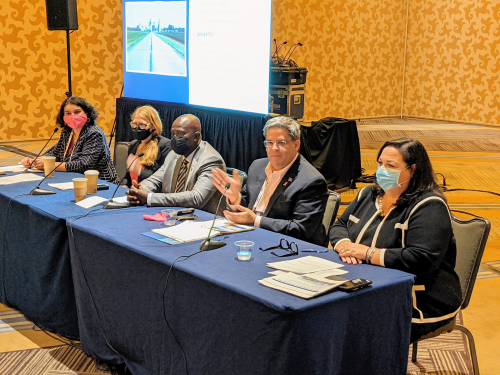Several state department of transportation executives recently shared insights into how their agencies are advancing equity through infrastructure projects during a knowledge session at the American Association of State Highway and Transportation Officials annual meeting in San Diego.
[Above photo left to right: Diana Mendes, HNTB; Shoshana Lew, Colorado DOT; Paul Ajegba, Michigan DOT; Bill Panos, North Dakota DOT; and Marie Therese Dominguez, New York State DOT.]
“I think we as leaders have to strive for a diverse workforce and get diverse opinions. When we have true representation in the room, we have true inclusive decision-making,” explained Paul Ajegba, director of the Michigan Department of Transportation. “In the past with our transportation projects, we would make decisions and then come back and say ‘was that the right decision?’ We had those questions because did not have the right representation at the beginning.”
Bill Panos, director of the North Dakota Department of Transportation, emphasized that “advancing equity” is not just an urban-focused philosophy. It also applies to transportation work in rural communities as well.
“In rural states, you can drive for four hours and not see another human being,” he said. “Rural states like mine have small populations and large landmasses, which makes for isolated communities. A major snowstorm might lock those communities down for up to a week: you cannot get a car or truck out; you cannot get food or fuel in. That happens to many of them two or three times per year.”
Panos stressed that in primarily rural and small states, a strong federal formula program is the key to sustaining equity. “For rural states like mine, we don’t have a lot of transportation funding options; we don’t have a large population or businesses to tax. That’s why for us 50 percent or more of our transportation dollars come from the federal government. That’s why formula funding is so important – it sustains us and helps maintain the national supply chains that run through our state.”
Shoshana Lew, executive director of the Colorado Department of Transportation, explained that forging closer connections to the communities impacted by transportation projects is another key to advancing equity.
“One of the areas we’ve particularly focused on is the project planning process,” she said. “Not only do we make ourselves more approachable and accessible, but we also use bilingual translators to better connect with the communities impacted by our projects. That helps us generate very real and meaningful dialog.”
Colorado DOT is also trying to “integrate” infrastructure projects better within the communities those structures serve. For example, for the recently completed I-70 highway project in Denver, the agency refurbished homes located near the road to mitigate noise and air pollution. Colorado DOT also helped redesign an elementary school located near the roadway, built parks for the children of families living near the highway, and regularly conducted job fairs during construction to provide employment opportunities to the residents of the communities near the roadway.
“That’s connecting them to economic benefits and long-term employment,” Lew noted. “We have taken this experience [with the I-70 project] – a hard one with ups and downs – and are using it to help us promote equity with other projects.”
Marie Therese Dominguez, the commissioner of the New York State Department of Transportation, said making sure everyone in the community benefits from a transportation project also means working more closely with other state and local agencies.
It means working with housing authorities so they can reconfigure post-project space for homes, along with education departments to determine how long-term construction could affect schools.
“It’s about bringing all the state and local agencies together to form a long-term plan – to factor in environmental, housing, and workforce impacts so we get a much more regional and comprehensive look at how a transportation project affects the communities it touches,” she said. “It is all about lifting everyone up because transportation really expands opportunity for communities of kinds.”

